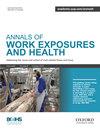214 拟议的亚洲职业接触限值框架
IF 1.8
4区 医学
Q3 PUBLIC, ENVIRONMENTAL & OCCUPATIONAL HEALTH
引用次数: 0
摘要
职业接触限值(OEL)是职业卫生的重要工具,用于保护在工作场所可能接触到健康危害的工人。通常情况下,职业接触限值为 8 小时 TWA、15 分钟 STEL 或天花板的单一值。虽然有人认为这些数值并不是安全与不安全之间的分界线,但人们普遍认为这些数值是工作场所是否可以接受的分界线。如果工人的接触水平超过了 OEL 值,雇主和雇员很难通过简单地与 OEL 值进行比较来了解其危险程度。例如,如果接触水平是 OELs 的 1.2 倍,那么从数字上看,接触水平比 OELs 高出 20%。但是,这并不意味着超过 20% 就很危险。对于某些化学品来说,这是非常危险的,但对于其他化学品来说,可能并不那么危险。因此,没有受过工业卫生培训的人不应该使用它。然而,在许多工作场所,如中小型企业,获得训练有素的工业卫生专家的机会非常有限。相反,它提高了传感器和直读仪器等自我测量技术的可及性。此外,如果考虑到经济可行性,为不同国家和/或地区和/或行业提供单一数值作为 OEL 可能是不切实际的。因此,亚洲职业卫生网(ANOH)制定了新的亚洲职业接触限值框架,为每种健康危害提供了理想、建议和最高三个级别。将介绍 ANOH-OEL 框架的背景、原理和发展。本文章由计算机程序翻译,如有差异,请以英文原文为准。
214 A proposed Asian occupational exposure limit framework
Occupational exposure limits (OELs) are key tools in occupational hygiene to protect workers who may be exposed to health hazards in their workplace. Typically OELs are given a single value for 8 hr-TWA, 15 min STEL or Ceiling. Although it is suggested that these values are not the fine lines between safe and unsafe, they are generally perceived as the fine lines of whether it is acceptable in the fields. If a worker’s exposure exceeds the OELs, employers and employees hardly know how dangerous it is by simply comparing it with OELs. For example, if the exposure level is 1.2X OELs, the exposure numerically exceeds 20% above the OELs. However, it does not mean that it is dangerous as much of 20%. It would be very dangerous for certain chemicals but might not be so dangerous for others. Therefore, it should not be used by anyone untrained in the discipline of industrial hygiene. However, in many workplaces, like SMEs, accessibility to trained industrial hygienists is very limited. On the contrary, it increases the accessibility of self-measurement techniques such as sensors and direct reading instruments. In addition, it might be impractical to provide a single value as an OEL to different countries and/or regions and/or industries if economic feasibility considered. Thus, Asian Network of Occupational Hygiene (ANOH) developed a New Asian Occupational Exposure Limit Framework, which provide 3 levels; ideal, recommended and maximum for each health hazards. Background, Rationale and Development of ANOH-OEL Framework will be presented.
求助全文
通过发布文献求助,成功后即可免费获取论文全文。
去求助
来源期刊

Annals Of Work Exposures and Health
Medicine-Public Health, Environmental and Occupational Health
CiteScore
4.60
自引率
19.20%
发文量
79
期刊介绍:
About the Journal
Annals of Work Exposures and Health is dedicated to presenting advances in exposure science supporting the recognition, quantification, and control of exposures at work, and epidemiological studies on their effects on human health and well-being. A key question we apply to submission is, "Is this paper going to help readers better understand, quantify, and control conditions at work that adversely or positively affect health and well-being?"
We are interested in high quality scientific research addressing:
the quantification of work exposures, including chemical, biological, physical, biomechanical, and psychosocial, and the elements of work organization giving rise to such exposures;
the relationship between these exposures and the acute and chronic health consequences for those exposed and their families and communities;
populations at special risk of work-related exposures including women, under-represented minorities, immigrants, and other vulnerable groups such as temporary, contingent and informal sector workers;
the effectiveness of interventions addressing exposure and risk including production technologies, work process engineering, and personal protective systems;
policies and management approaches to reduce risk and improve health and well-being among workers, their families or communities;
methodologies and mechanisms that underlie the quantification and/or control of exposure and risk.
There is heavy pressure on space in the journal, and the above interests mean that we do not usually publish papers that simply report local conditions without generalizable results. We are also unlikely to publish reports on human health and well-being without information on the work exposure characteristics giving rise to the effects. We particularly welcome contributions from scientists based in, or addressing conditions in, developing economies that fall within the above scope.
 求助内容:
求助内容: 应助结果提醒方式:
应助结果提醒方式:


